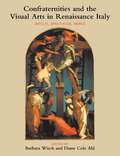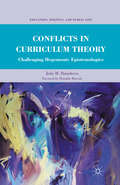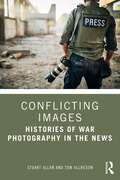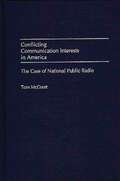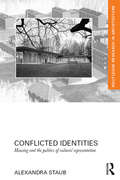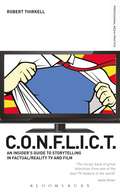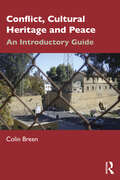- Table View
- List View
Conjugations: Marriage and Form in New Bollywood Cinema (South Asia Across the Disciplines)
by Sangita GopalBollywood movies have been long known for their colorful song-and-dance numbers and knack for combining drama, comedy, action-adventure, and music. But when India entered the global marketplace in the early 1990s, its film industry transformed radically. Production and distribution of films became regulated, advertising and marketing created a largely middle-class audience, and films began to fit into genres like science fiction and horror. In this bold study of what she names New Bollywood, Sangita Gopal contends that the key to understanding these changes is to analyze films’ evolving treatment of romantic relationships. Gopalargues that the form of the conjugal duo in movies reflects other social forces in India’s new consumerist and global society. She takes a daring look at recent Hindi films and movie trends—the decline of song-and-dance sequences, the upgraded status of the horror genre, and the rise of the multiplex and multi-plot—to demonstrate how these relationships exemplify different formulas of contemporary living. A provocative account of how cultural artifacts can embody globalization’s effects on intimate life, Conjugations will shake up the study of Hindi film.
Conjugations: Marriage and Form in New Bollywood Cinema (South Asia Across the Disciplines)
by Sangita GopalBollywood movies have been long known for their colorful song-and-dance numbers and knack for combining drama, comedy, action-adventure, and music. But when India entered the global marketplace in the early 1990s, its film industry transformed radically. Production and distribution of films became regulated, advertising and marketing created a largely middle-class audience, and films began to fit into genres like science fiction and horror. In this bold study of what she names New Bollywood, Sangita Gopal contends that the key to understanding these changes is to analyze films’ evolving treatment of romantic relationships. Gopalargues that the form of the conjugal duo in movies reflects other social forces in India’s new consumerist and global society. She takes a daring look at recent Hindi films and movie trends—the decline of song-and-dance sequences, the upgraded status of the horror genre, and the rise of the multiplex and multi-plot—to demonstrate how these relationships exemplify different formulas of contemporary living. A provocative account of how cultural artifacts can embody globalization’s effects on intimate life, Conjugations will shake up the study of Hindi film.
Conjugations: Marriage and Form in New Bollywood Cinema (South Asia Across the Disciplines)
by Sangita GopalBollywood movies have been long known for their colorful song-and-dance numbers and knack for combining drama, comedy, action-adventure, and music. But when India entered the global marketplace in the early 1990s, its film industry transformed radically. Production and distribution of films became regulated, advertising and marketing created a largely middle-class audience, and films began to fit into genres like science fiction and horror. In this bold study of what she names New Bollywood, Sangita Gopal contends that the key to understanding these changes is to analyze films’ evolving treatment of romantic relationships. Gopalargues that the form of the conjugal duo in movies reflects other social forces in India’s new consumerist and global society. She takes a daring look at recent Hindi films and movie trends—the decline of song-and-dance sequences, the upgraded status of the horror genre, and the rise of the multiplex and multi-plot—to demonstrate how these relationships exemplify different formulas of contemporary living. A provocative account of how cultural artifacts can embody globalization’s effects on intimate life, Conjugations will shake up the study of Hindi film.
Conjugations: Marriage and Form in New Bollywood Cinema (South Asia Across the Disciplines)
by Sangita GopalBollywood movies have been long known for their colorful song-and-dance numbers and knack for combining drama, comedy, action-adventure, and music. But when India entered the global marketplace in the early 1990s, its film industry transformed radically. Production and distribution of films became regulated, advertising and marketing created a largely middle-class audience, and films began to fit into genres like science fiction and horror. In this bold study of what she names New Bollywood, Sangita Gopal contends that the key to understanding these changes is to analyze films’ evolving treatment of romantic relationships. Gopalargues that the form of the conjugal duo in movies reflects other social forces in India’s new consumerist and global society. She takes a daring look at recent Hindi films and movie trends—the decline of song-and-dance sequences, the upgraded status of the horror genre, and the rise of the multiplex and multi-plot—to demonstrate how these relationships exemplify different formulas of contemporary living. A provocative account of how cultural artifacts can embody globalization’s effects on intimate life, Conjugations will shake up the study of Hindi film.
Confucius’ Courtyard: Architecture, Philosophy And The Good Life In China
by Xing RuanFor more than three thousand years, Chinese life – from the city and the imperial palace, to the temple, the market and the family home – was configured around the courtyard. So too were the accomplishments of China's artistic, philosophical and institutional classes. Confucius' Courtyard tells the story of how the courtyard – that most singular and persistent architectural form – holds the key to understanding, even today, much of Chinese society and culture. Part architectural history, and part introduction to the cultural and philosophical history of China, the book explores the Chinese view of the world, and reveals the extent to which this is inextricably intertwined with the ancient concept of the courtyard, a place and a way of life which, it appears, has been almost entirely overlooked in China since the middle of the 20th century, and in the West for centuries. Along the way, it provides an accessible introduction to the Confucian idea of zhongyong ('the Middle Way'), the Chinese moral universe and the virtuous good life in the absence of an awesome God, and shows how these can only be fully understood through the humble courtyard – a space which is grounded in the earth, yet open to the heavens. Erudite, elegant and illustrated throughout by the author's own architectural drawings and sketches, Confucius' Courtyard weaves together architecture, philosophy and cultural history to explore what lies at the very heart of Chinese civilization.
Confronting Visuality in Multi-Ethnic Women’s Writing
by A. LaflenConsidering new perspectives on writers such as Toni Morrison, Margaret Atwood, and Louise Erdrich, Confronting Visuality in Multi-ethnic Women's Writing traces a cross-cultural tradition in which contemporary female writers situate images of women within larger contexts of visuality.
Confronting Suburbanization: Urban Decentralization in Postsocialist Central and Eastern Europe (IJURR Studies in Urban and Social Change Book Series)
by Kiril Stanilov Lud 277 K SýkoraThis fascinating book explains the processes of suburbanization in the context of post-socialist societies transitioning from one system of socio-spatial order to another. Case studies of seven Central and Eastern Europe city regions illuminate growth patterns and key conditions for the emergence of sprawl. Breaks new ground, offering a systematic approach to the analysis of the global phenomenon of suburbanization in a post-socialist context Tracks the boom of the post-socialist suburbs in seven CEE capital city regions – Budapest, Ljubljana, Moscow, Prague, Sofia, Tallinn, and Warsaw Situates the experience of the CEE countries in the broader context of global urban change Case studies examine the phenomenon of suburbanization along four main vectors of analysis related to development patterns, driving forces, consequences and impacts, and management of suburbanization Highlights the critical importance of public policies and planning on the spread of suburbanization
Confronting Suburbanization: Urban Decentralization in Postsocialist Central and Eastern Europe (IJURR Studies in Urban and Social Change Book Series)
by Kiril Stanilov Luděk SýkoraThis fascinating book explains the processes of suburbanization in the context of post-socialist societies transitioning from one system of socio-spatial order to another. Case studies of seven Central and Eastern Europe city regions illuminate growth patterns and key conditions for the emergence of sprawl. Breaks new ground, offering a systematic approach to the analysis of the global phenomenon of suburbanization in a post-socialist context Tracks the boom of the post-socialist suburbs in seven CEE capital city regions – Budapest, Ljubljana, Moscow, Prague, Sofia, Tallinn, and Warsaw Situates the experience of the CEE countries in the broader context of global urban change Case studies examine the phenomenon of suburbanization along four main vectors of analysis related to development patterns, driving forces, consequences and impacts, and management of suburbanization Highlights the critical importance of public policies and planning on the spread of suburbanization
Confronting Shame: How to Understand Your Shame and Gain Inner Freedom
by Ilse SandShame might be far from the first thing that comes to mind when you think about what's causing your problems. Shame is hidden, and rarely something we talk about, but it can underlie challenges that we deal with on a daily basis, including anxiety, depression and low self-esteem. This book will help you understand what shame is, how it arises and, in turn, how to overcome it. With exercises in each chapter, it provides tools to reflect on, confront and free yourself from shame. The book also includes a questionnaire to assess how much shame impacts you.Be kind to yourself and rediscover your empathy for yourself with Confronting Shame.
Confraternities And The Visual Arts In Renaissance Italy: Ritual, Spectacle, Image (PDF)
by Barbara Wisch Diane Cole AhlFirst published in 2000, Confraternities and the Visual Arts in Renaissance Italy: Ritual, Spectacle, Image was the first book to consider the role of Italian confraternities in the patronage of art. Eleven interdisciplinary essays analyze confraternal painting, sculpture, architecture, and dramatic spectacles by documenting the unique historical and ritual contexts in which they were experienced. Exploring the evolution of devotional practices, the roles of women and youths, the age's conception of charity, and the importance of confraternities in civic politics and urban design, this book offers illuminating approaches to one of the most dynamic forms of corporate patronage in early modern Italy.
Confluence of Computer Vision and Computer Graphics (NATO Science Partnership Subseries: 3 #84)
by Ales Leonardis F. Solina Ruzena BajcsyA collection of original contributions by researchers who work at the forefront of a new field, lying at the intersection of computer vision and computer graphics. Several original approaches are presented to the integration of computer vision and graphics techniques to aid in the realistic modelling of objects and scenes, interactive computer graphics, augmented reality, and virtual studios. Numerous applications are also discussed, including urban and archaeological site modelling, modelling dressed humans, medical visualisation, figure and facial animation, real-time 3D teleimmersion telecollaboration, augmented reality as a new user interface concept, and augmented reality in the understanding of underwater scenes.
Conflicts in Curriculum Theory: Challenging Hegemonic Epistemologies (Education, Politics and Public Life)
by João M. ParaskevaThis book challenges educators to be agents of change, to take history into their own hands, and to make social justice central to the educational endeavor. Paraskeva embraces a pedagogy of hope championed by Paulo Freire where people become conscious of their capacity to intervene in the world to make it less discriminatory and more humane.
Conflicting Masculinities: Men in Television Period Drama (Library Of Gender And Popular Culture Ser.)
by Katherine Byrne Julie Anne Taddeo James LeggottNever before has period drama offered viewers such an assortment of complex male characters, from transported felons and syphilitic detectives to shell shocked soldiers and gangland criminals. Neo-Victorian Gothic fictions like Penny Dreadful represent masculinity at its darkest, Poldark and Outlander have refashioned the romantic hero and anti-heritage series like Peaky Blinders portray masculinity in crisis, at moments when the patriarchy was being bombarded by forces like World War I, the rise of first wave feminism and the breakdown of Empire. Scholars of film, media, literature and history explore the very different types of maleness offered by contemporary television and show how the intersection of class, race, history and masculinity in period dramas has come to hold such broad appeal to twenty-first-century audiences.
Conflicting Images: Histories of War Photography in the News
by Stuart Allan Tom AllbesonIn contrast with historical examinations centring the evolving role of the war correspondent, Conflicting Images focuses on the contribution of photographers and photojournalists, providing an evaluative appraisal of war photography in the news and its development from the nineteenth century to the twenty-first century.Stuart Allan and Tom Allbeson critically explore diverse genres of war photography across a broad historical sweep, encompassing events from the Crimean War (1853–56) and the Civil War in the United States (1861–65) up to and including conflicts unfolding in Syria and Ukraine. This book reflects on the relevance of different types of warfare to visual reporting, from colonial conquest via trench warfare and aerial bombardment, to the ideological dimensions of the Cold War, and ‘embedding’ and ‘winning hearts and minds’ during the ‘War on Terror’ and its aftermath. In pinpointing illustrative examples, the authors examine changing dynamics of production, dissemination, and public engagement. Readers will come to understand how current efforts to rethink the future of war photography in a digital age can benefit from a close and careful consideration of war photography’s origins, early development, and gradual, uneven transformation over the years. Conflicting Images aims to invigorate ongoing enquires and inspire new, alternative trajectories for future research and practice.This book is recommended reading for researchers and advanced students of visual journalism and conflict reporting.
Conflicting Images: Histories of War Photography in the News
by Stuart Allan Tom AllbesonIn contrast with historical examinations centring the evolving role of the war correspondent, Conflicting Images focuses on the contribution of photographers and photojournalists, providing an evaluative appraisal of war photography in the news and its development from the nineteenth century to the twenty-first century.Stuart Allan and Tom Allbeson critically explore diverse genres of war photography across a broad historical sweep, encompassing events from the Crimean War (1853–56) and the Civil War in the United States (1861–65) up to and including conflicts unfolding in Syria and Ukraine. This book reflects on the relevance of different types of warfare to visual reporting, from colonial conquest via trench warfare and aerial bombardment, to the ideological dimensions of the Cold War, and ‘embedding’ and ‘winning hearts and minds’ during the ‘War on Terror’ and its aftermath. In pinpointing illustrative examples, the authors examine changing dynamics of production, dissemination, and public engagement. Readers will come to understand how current efforts to rethink the future of war photography in a digital age can benefit from a close and careful consideration of war photography’s origins, early development, and gradual, uneven transformation over the years. Conflicting Images aims to invigorate ongoing enquires and inspire new, alternative trajectories for future research and practice.This book is recommended reading for researchers and advanced students of visual journalism and conflict reporting.
Conflicting Communication Interests in America: The Case of National Public Radio
by Tom McCourtPublic broadcasting has changed dramatically since its founding in 1967. The growing equation of marketplace efficiency with the public interest has, in Tom McCourt's analysis, undermined the value of public goods and services. In addition, political and cultural discourse is increasingly beset by fragmentation. Public radio provides an exemplary site to examine the prospects and problems of contemporary public life.Beginning with a description of the events that led to the creation of National Public Radio, McCourt discusses the relationship between NPR and its affiliate stations and the ways in which struggles over funding and programming have affected public radio's agenda. He also examines how public radio incorporates the roles of public representatives into its operations and how its methods to determine the needs and interests of the public have changed across the system's history. The social, political, and economic pressures that have impacted the mission and practices of National Public Radio, McCourt asserts, are manifest in all areas of American life. Through extensive historical research, he examines whether American public broadcasters, as represented by NPR, have succeeded or failed to engender an enlightened, participatory democracy.
Conflicted Identities: Housing and the Politics of Cultural Representation (Routledge Research in Architecture)
by Alexandra StaubNation-states have long used representational architecture to create symbolic identities for public consumption both at home and abroad. Government buildings, major ensembles and urban plans have a visibility that lends them authority, while their repeated portrayals in the media cement their image as icons of a shared national character. Existing in tandem with this official self, however, is a second, often divergent identity, represented by the vast realm of domestic space defined largely by those who occupy it as well as those with a vested interest in its cultural meaning. Using both historical inquiry and visual, spatial and film analysis, this book explores the interaction of these two identities, and its effect on political control, class status, and gender roles. Conflicted Identities examines the politicization of both public and domestic space, especially in societies undergoing rapid cultural transformation through political, social or economic expansion or restructuring, when cultural identity is being rapidly "modernized", shifted, or realigned to conform to new demands. Using specific examples from a variety of national contexts, the book examines how vernacular housing, legislation, marketing, and media influence a large, but often underexposed domestic culture that runs parallel to a more publicly represented one. As a case in point, the book examines West Germany from the end of World War II to the early 1970s to probe more deeply into the mechanisms of such cultural dichotomy. On a national level, post-war West Germany demonstratively rejected Nazi-era values by rebuilding cities based on interwar modernist tenets, while choosing a decidedly modern and transparent architecture for high-visibility national projects. In the domestic realm, government, media and everyday citizens countered this turn to state-sponsored modernism by embracing traditional architectural aesthetics and housing that encouraged patriarchal family structures. Written for readers interested in cultural theory, history, and the politics of space as well as those engaged with architecture and the built environment, Conflicted Identities provides an engaging new perspective on power and identity as they relate to architectural settings.
Conflicted Identities: Housing and the Politics of Cultural Representation (Routledge Research in Architecture)
by Alexandra StaubNation-states have long used representational architecture to create symbolic identities for public consumption both at home and abroad. Government buildings, major ensembles and urban plans have a visibility that lends them authority, while their repeated portrayals in the media cement their image as icons of a shared national character. Existing in tandem with this official self, however, is a second, often divergent identity, represented by the vast realm of domestic space defined largely by those who occupy it as well as those with a vested interest in its cultural meaning. Using both historical inquiry and visual, spatial and film analysis, this book explores the interaction of these two identities, and its effect on political control, class status, and gender roles. Conflicted Identities examines the politicization of both public and domestic space, especially in societies undergoing rapid cultural transformation through political, social or economic expansion or restructuring, when cultural identity is being rapidly "modernized", shifted, or realigned to conform to new demands. Using specific examples from a variety of national contexts, the book examines how vernacular housing, legislation, marketing, and media influence a large, but often underexposed domestic culture that runs parallel to a more publicly represented one. As a case in point, the book examines West Germany from the end of World War II to the early 1970s to probe more deeply into the mechanisms of such cultural dichotomy. On a national level, post-war West Germany demonstratively rejected Nazi-era values by rebuilding cities based on interwar modernist tenets, while choosing a decidedly modern and transparent architecture for high-visibility national projects. In the domestic realm, government, media and everyday citizens countered this turn to state-sponsored modernism by embracing traditional architectural aesthetics and housing that encouraged patriarchal family structures. Written for readers interested in cultural theory, history, and the politics of space as well as those engaged with architecture and the built environment, Conflicted Identities provides an engaging new perspective on power and identity as they relate to architectural settings.
Conflict Transformation and Social Change in Uganda: Remembering after Violence (Rethinking Peace and Conflict Studies)
by Susanne Buckley-ZistelDrawing on the concept of hermeneutics the book argues that the successes and setbacks of conflict transformation in Teso can be understood through analyzing the impact of memory, identity, closure and power on social change and calls for a comprehensive effort of dealing with the past in war-torn societies.
CONFLICT - The Insiders' Guide to Storytelling in Factual/Reality TV & Film (Professional Media Practice)
by Robert Thirkell"The recipe book of great television from one of the best TV makers in the world" Jamie OliverStory structure is a huge weakness for many factual or reality filmmakers and TV producers, who often concentrate on subject areas and issues rather than dramatic and memorable narrative. Consequently programmes fail to attract the audience or win any awards.In this book Robert Thirkell, the international consultant known as 'The TV Troubleshooter' and renowned television producer, sets out a professional toolkit for developing a compelling storyline in factual and reality programmes and films. Based on his popular international C.O.N.F.L.I.C.T seminars, it lifts the lids on the making of leading series such as Kitchen Nightmares, Wife Swap, The Apprentice, Coastguards, Firefighters, Oprah's Big Give Fat March, Jamie's School Dinners and When Big Chef Met Little Chef as well as offering insight and advice from leading filmmakers and TV producers worldwide.The tips and tools go right the way through the filmmaking process from finding stories and characters, to structuring scripts and filming, editing, through to delivery, titles and getting people to watch.
CONFLICT - The Insiders' Guide to Storytelling in Factual/Reality TV & Film: An Insiders' Guide To Storytelling In Factual/reality Tv And Film (Professional Media Practice)
by Robert Thirkell"The recipe book of great television from one of the best TV makers in the world" Jamie OliverStory structure is a huge weakness for many factual or reality filmmakers and TV producers, who often concentrate on subject areas and issues rather than dramatic and memorable narrative. Consequently programmes fail to attract the audience or win any awards.In this book Robert Thirkell, the international consultant known as 'The TV Troubleshooter' and renowned television producer, sets out a professional toolkit for developing a compelling storyline in factual and reality programmes and films. Based on his popular international C.O.N.F.L.I.C.T seminars, it lifts the lids on the making of leading series such as Kitchen Nightmares, Wife Swap, The Apprentice, Coastguards, Firefighters, Oprah's Big Give Fat March, Jamie's School Dinners and When Big Chef Met Little Chef as well as offering insight and advice from leading filmmakers and TV producers worldwide.The tips and tools go right the way through the filmmaking process from finding stories and characters, to structuring scripts and filming, editing, through to delivery, titles and getting people to watch.
Conflict Graffiti: From Revolution to Gentrification
by John LennonThis study examines the waves of graffiti that occur before, during, and after a conflict—important tools of political resistance that make protest visible and material. Graffiti makes for messy politics. In film and television, it is often used to create a sense of danger or lawlessness. In bathroom stalls, it is the disembodied expression of gossip, lewdness, or confession. But it is also a resistive tool of protest, making visible the disparate voices and interests that come together to make a movement. In Conflict Graffiti, John Lennon dives into the many permutations of graffiti in conflict zones—ranging from the protest graffiti of the Black Lives Matter movement in Ferguson and the Tahrir Square demonstrations in Egypt, to the tourist-attraction murals on the Israeli Separation Wall and the street art that has rebranded Detroit and post-Katrina New Orleans. Graffiti has played a crucial role in the revolutionary movements of these locales, but as the conflict subsides a new graffiti and street art scene emerges—often one that ushers in postconflict consumerism, gentrification, militarization, and anesthetized forgetting. Graffiti has an unstable afterlife, fated to be added to, transformed, overlaid, photographed, reinterpreted, or painted over. But as Lennon concludes, when protest movements change and adapt, graffiti is also uniquely suited to shapeshift with them.
Conflict Graffiti: From Revolution to Gentrification
by John LennonThis study examines the waves of graffiti that occur before, during, and after a conflict—important tools of political resistance that make protest visible and material. Graffiti makes for messy politics. In film and television, it is often used to create a sense of danger or lawlessness. In bathroom stalls, it is the disembodied expression of gossip, lewdness, or confession. But it is also a resistive tool of protest, making visible the disparate voices and interests that come together to make a movement. In Conflict Graffiti, John Lennon dives into the many permutations of graffiti in conflict zones—ranging from the protest graffiti of the Black Lives Matter movement in Ferguson and the Tahrir Square demonstrations in Egypt, to the tourist-attraction murals on the Israeli Separation Wall and the street art that has rebranded Detroit and post-Katrina New Orleans. Graffiti has played a crucial role in the revolutionary movements of these locales, but as the conflict subsides a new graffiti and street art scene emerges—often one that ushers in postconflict consumerism, gentrification, militarization, and anesthetized forgetting. Graffiti has an unstable afterlife, fated to be added to, transformed, overlaid, photographed, reinterpreted, or painted over. But as Lennon concludes, when protest movements change and adapt, graffiti is also uniquely suited to shapeshift with them.
Conflict, Cultural Heritage and Peace: An Introductory Guide
by Colin BreenConflict, Cultural Heritage and Peace offers a series of conceptual and applied frameworks to help understand the role cultural heritage plays within conflict and the potential it has to contribute to positive peacebuilding and sustainable development in post-conflict societies. Designed as a resource guide, this general volume introduces the multiple roles cultural heritage plays through the conflict cycle from its onset, subsequent escalation and through to resolution and recovery. In its broadest sense, it questions what role cultural heritage plays within conflict, how cultural heritage is used in the construction and justification of conflict narratives, how are these narratives framed and often manipulated to support particular perspectives, and how we can develop better understandings of cultural heritage and work towards the better protection of cultural heritage resources during conflict. It moves beyond the protection paradigm and recognises that cultural heritage can contribute to building peace and reconciliation in post-conflict environments. The study offers a conceptual and operational framework to understand the roles cultural heritage plays within conflict cycles, how it can be targeted during war, and the potential cultural heritage has in positive peacebuilding across the conflict lifecycle. Conflict, Cultural Heritage, and Peace offers an invaluable introduction to cultural heritage at all stages in conflict scenarios which will benefit students, researchers and practitioners in the field of heritage, environment, peace and conflict studies.
Conflict, Cultural Heritage and Peace: An Introductory Guide
by Colin BreenConflict, Cultural Heritage and Peace offers a series of conceptual and applied frameworks to help understand the role cultural heritage plays within conflict and the potential it has to contribute to positive peacebuilding and sustainable development in post-conflict societies. Designed as a resource guide, this general volume introduces the multiple roles cultural heritage plays through the conflict cycle from its onset, subsequent escalation and through to resolution and recovery. In its broadest sense, it questions what role cultural heritage plays within conflict, how cultural heritage is used in the construction and justification of conflict narratives, how are these narratives framed and often manipulated to support particular perspectives, and how we can develop better understandings of cultural heritage and work towards the better protection of cultural heritage resources during conflict. It moves beyond the protection paradigm and recognises that cultural heritage can contribute to building peace and reconciliation in post-conflict environments. The study offers a conceptual and operational framework to understand the roles cultural heritage plays within conflict cycles, how it can be targeted during war, and the potential cultural heritage has in positive peacebuilding across the conflict lifecycle. Conflict, Cultural Heritage, and Peace offers an invaluable introduction to cultural heritage at all stages in conflict scenarios which will benefit students, researchers and practitioners in the field of heritage, environment, peace and conflict studies.





